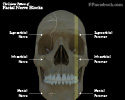II. Indication
- Regional Anesthesia for upper lip and upper teeth, cheeks, nose (part), lower Eyelid
III. Physiology: Landmarks for Infraorbital Nerve
- Infraorbital nerve arises from the Maxillary nerve, whch is a V2 portion of Trigeminal Nerve
- Images
- Exits skull at infraorbital foramen along the infraoribtal ridge
- Centered below midline of orbit, in line with mid-pupil on forward gaze
IV. Technique: Infraorbital Nerve Block (extraoral approach)
- Locate infraorbital foramen as above
- Insert needle
- Examiner places one finger over the infraorbital ridge
- Insert inferior to foramen by 1 cm (slightly medial)
- Direct needle toward supraorbital foramen and superolaterally
- Avoid approaching orbit
- Infiltrate at infraorbital foramen
- Aspirate first to confirm not in facial artery or facial vein
- Use 2-4 cc of 1% Lidocaine
- Inject just above bone level
- Redirect needle if Paresthesias or sharp pain
V. Technique: Infraorbital Nerve Block (intraoral approach)
- Consider applying Topical Anesthetic to the mucosa at the injection site
- Examiner positions non-dominant hand
- Examiner places middle finger on infraorbital ridge at infraorbital foramen
- Examiner grasps the patients lip between their thumb and index finger retracting the lip upward and outward
- Insert needle
- In line with the second premolar, directed toward the infraorbital foramen
- Advance the needle toward the infraorbital foramen
- Exercise caution
- Do not go beyond the bony orbit
- Avoid entering the infraorbital foramen
- Infiltrate the infraorbital foramen
- Use 1-3 ml of Lidocaine 1%
- Advantages
- Intraoral approach delivered Anesthetic lasts twice as long as extraoral delivered Anesthetic
VI. References
- Moy in Pfenninger (1994) Procedures, p. 145-55
- Salam (2004) Am Fam Physician 69(3):585-90 [PubMed]
- Latham (2014) Am Fam Physician 89(12): 956-62 [PubMed]

